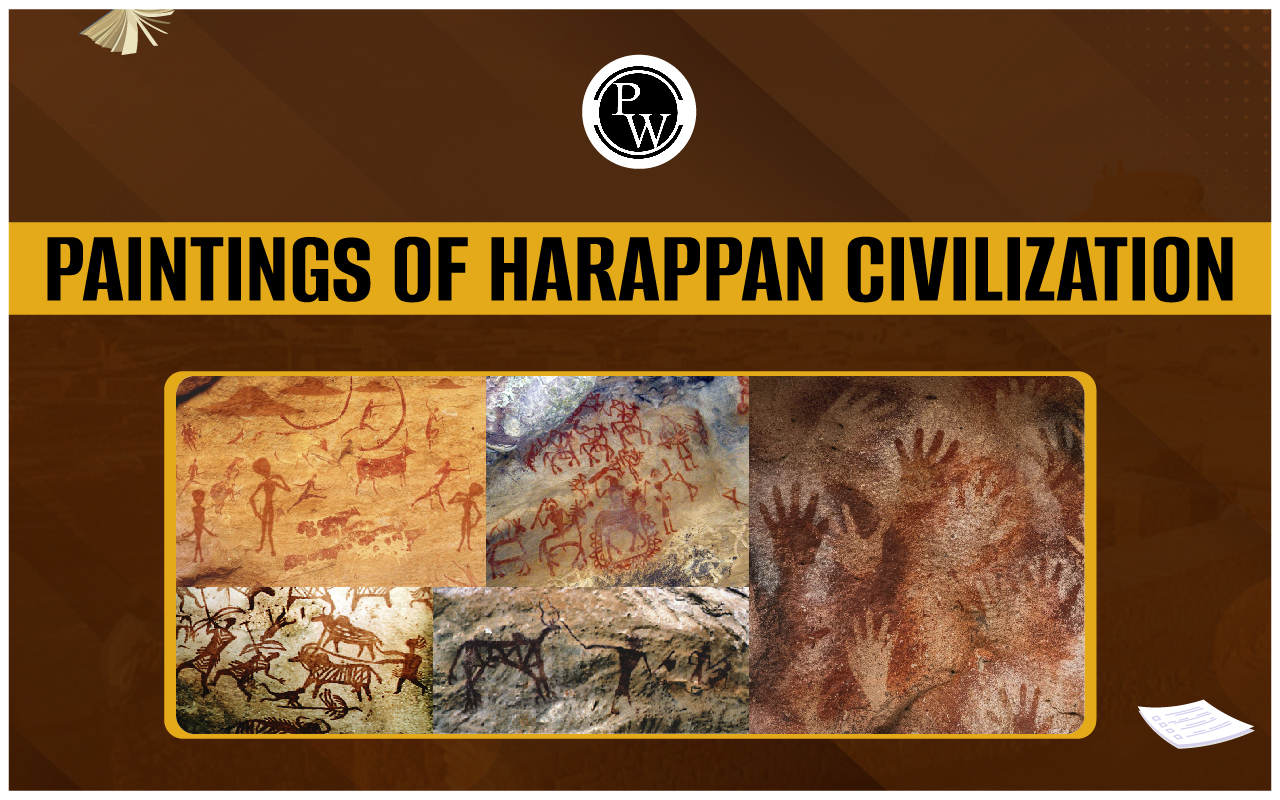

Paintings of Harappan Civilization: The Indus Valley Civilization, also known as the Harappan Civilization, was a Bronze Age civilization that thrived in northwestern South Asia between 3300 and 1300 BCE. It reached its peak from 2600 to 1900 BCE. This civilization was one of the earliest in the Near East and South Asia, alongside ancient Egypt and Mesopotamia, and it was the largest of the three. The Harappan Civilization spread across present-day Pakistan, northeastern Afghanistan, and northwestern India. It flourished along a network of rivers that were fed by monsoons, particularly near the seasonal Ghaggar-Hakra River and the Indus River's alluvial plains in Pakistan.
The Harappan Civilization is renowned for its advanced urban planning, architecture, and social organization. Among its many cultural achievements, the Paintings of Harappan Civilization stand out, showcasing the artistic skills of its people. These paintings, along with other artifacts, provide a glimpse into the daily life and beliefs of the Harappans. The Paintings of Harappan Civilization are a valuable part of its rich heritage, offering insights into a civilization that was remarkably sophisticated for its time.Harappan Civilization Discovery and Excavation
The discovery of the Harappan or Indus Valley Civilization began with Charles Masson, a deserter from the East India Company’s soldiers. In 1829, Masson traveled through the princely state of Punjab, offering valuable information to the Company in exchange for a pardon. Masson's most significant find was Harappa, a major city of the Indus civilization located in the Ravi river valley. He carefully recorded and sketched numerous historical artifacts, many of which were partially buried.In 1842, Masson wrote a book called "Narrative of Various Journeys in Baluchistan, Afghanistan, and the Punjab," where he talked about what he saw in Harappa. Although he mistakenly believed the ruins were from the time of Alexander’s conquest, the immense size of the site and the large mounds shaped by centuries of erosion left a lasting impression on him. Masson's accounts were crucial in bringing the ancient civilization of Harappa to the attention of the modern world.Harappan Civilization Art and Culture
The Harappan or Indus Valley Civilization, which flourished during the Bronze Age, is renowned for its rich art and culture. From sculptures and seals to pottery and jewelry, the artistic achievements of this civilization are remarkable.Harappan Art: Stone Statues
- Priest-King: Found in Mohenjo-Daro, this statue of a bearded man, likely a priest, is made of steatite. The figure wears a shawl with a trefoil pattern, and the eyes are half-closed as if in meditation.
- Male Torso: Discovered in Harappa, this red sandstone statue has socket holes for attaching the head and arms. The figure has well-defined shoulders and a slightly protruding midsection.
Harappan Art: Bronze Casting
- Bronze Figures: Using the lost wax method, the Harappans created numerous bronze figures, including animals like the buffalo and goat. Notable examples include the bronze bull from Kalibangan and copper dogs and birds from Lothal.
Harappan Art: Terracotta
- Terracotta Figures: Found mainly in Gujarat and Kalibangan, these figures include bearded men, deities, and everyday objects like wheeled carts and toys. The Mother Goddess statues are particularly significant.
Harappan Art: Seals
- Seals: Made primarily of steatite, these seals often depict animals such as the unicorn bull, rhinoceros, and elephant. They were used for trade and as amulets, featuring an undeciphered pictographic script.
Harappan Art: Pottery
- Pottery: Most pottery was wheel-made and featured plain red clay or geometric and animal designs in black paint. Painted pottery was less common but highly decorated.
Harappan Art: Beads and Ornaments
- Jewelry: Harappans wore jewelry made from a variety of materials, including gold, copper, and semi-precious stones. Bead factories in places like Chanhudaro and Lothal produced intricate beads and animal-shaped ornaments.
Harappan Civilization Architecture
The architecture of the Harappan Civilization is renowned for its urban planning, featuring baked brick homes, sophisticated water supply and drainage systems, and large non-residential structures, showcasing their advanced engineering skills and organizational abilities. You can read the given points below for better understanding.- Urban Planning: The ancient towns of the Indus Valley were known for their well-organized layout. They featured baked brick homes, intricate water supply, and drainage systems. These cities exhibited remarkable foresight in city planning, with streets laid out in a grid pattern.
- Population and Urbanization: Cities like Mohenjo-daro and Harappa boasted populations ranging from 30,000 to 60,000 people. At its peak, the civilization may have housed between one and five million inhabitants. This significant urbanization likely stemmed from environmental changes, such as decreasing water availability, during the third millennium BCE.
- Water Supply and Drainage: The Indus Valley Civilization developed sophisticated water supply and drainage systems. They constructed elaborate networks of channels and drains to manage water flow efficiently. This engineering marvel enabled the cities to thrive in an otherwise arid environment.
- Non-Residential Structures: Alongside residential areas, the Indus cities contained large non-residential structures, suggesting a complex social and economic organization. These structures served various purposes, possibly including religious, administrative, or commercial functions.
- Handicraft and Metallurgical Techniques: The Indus people were skilled artisans and metallurgists. They produced a wide range of handicrafts, including pottery, jewelry, and terracotta figurines. Metalworking was also advanced, with evidence of bronze and copper artifacts.
- Environmental Challenges: Despite their advancements, the civilization faced challenges, notably environmental changes that led to a decline in water availability. This drying up of the region may have contributed to the collapse of the civilization and the dispersal of its population eastward.
Paintings of Harappan Civilization FAQs
What is the Harappan Civilization?
The Harappan Civilization, also known as the Indus Valley Civilization, was a Bronze Age civilization that thrived in northwestern South Asia from around 3300 to 1300 BCE.
Where did the Harappan Civilization exist?
The Harappan Civilization spread across present-day Pakistan, northeastern Afghanistan, and northwestern India.
What were the main artistic achievements of the Harappan Civilization?
The Harappan Civilization was known for its sculptures, seals, pottery, bronze casting, terracotta figurines, and intricate jewelry.
What are some notable examples of Harappan art?
Examples of Harappan art include the Priest-King statue found in Mohenjo-Daro, bronze figures like the bronze bull from Kalibangan, and terracotta figurines found mainly in Gujarat and Kalibangan.
How did the Harappan people live?
The Harappan people lived in well-planned urban centers with sophisticated water supply and drainage systems. They engaged in handicrafts, metallurgy, and trade.
🔥 Trending Blogs
Talk to a counsellorHave doubts? Our support team will be happy to assist you!

Check out these Related Articles
Free Learning Resources
PW Books
Notes (Class 10-12)
PW Study Materials
Notes (Class 6-9)
Ncert Solutions
Govt Exams
Class 6th to 12th Online Courses
Govt Job Exams Courses
UPSC Coaching
Defence Exam Coaching
Gate Exam Coaching
Other Exams
Know about Physics Wallah
Physics Wallah is an Indian edtech platform that provides accessible & comprehensive learning experiences to students from Class 6th to postgraduate level. We also provide extensive NCERT solutions, sample paper, NEET, JEE Mains, BITSAT previous year papers & more such resources to students. Physics Wallah also caters to over 3.5 million registered students and over 78 lakh+ Youtube subscribers with 4.8 rating on its app.
We Stand Out because
We provide students with intensive courses with India’s qualified & experienced faculties & mentors. PW strives to make the learning experience comprehensive and accessible for students of all sections of society. We believe in empowering every single student who couldn't dream of a good career in engineering and medical field earlier.
Our Key Focus Areas
Physics Wallah's main focus is to make the learning experience as economical as possible for all students. With our affordable courses like Lakshya, Udaan and Arjuna and many others, we have been able to provide a platform for lakhs of aspirants. From providing Chemistry, Maths, Physics formula to giving e-books of eminent authors like RD Sharma, RS Aggarwal and Lakhmir Singh, PW focuses on every single student's need for preparation.
What Makes Us Different
Physics Wallah strives to develop a comprehensive pedagogical structure for students, where they get a state-of-the-art learning experience with study material and resources. Apart from catering students preparing for JEE Mains and NEET, PW also provides study material for each state board like Uttar Pradesh, Bihar, and others
Copyright © 2025 Physicswallah Limited All rights reserved.
Get App











